
The Psalter Manuscripts of Meteora
Maria Tomadaki
May 11, 2023
In the northwest plains of Thessaly, in Greece, lies Meteora, a majestic landscape of unique natural beauty. “Suspended in the air” on top of its towering rocks stand six Orthodox monasteries, which preserve a large number of Byzantine and post-Byzantine manuscripts.[i] I recently had the opportunity to visit three of these convents and study their Psalter manuscripts thanks to the kind permission of the monastic authorities and the financial support of the Göttingen Academy of Sciences and Humanities in Lower Saxony.
The Psalters of the Transfiguration Monastery
The monastery with the largest manuscript collection in Meteora is the so-called Great Meteoron, or Monastery of the Transfiguration (Metamorfoseos). It preserves seventeen Psalter manuscripts from the fourteenth to sixteenth centuries. Most of these date from ca. 1500–1570 (Ra 7023, Ra 7025, Ra 7026, Ra 7028, Ra 7029, Ra 7031, Ra 7033, Ra 7034, Ra 7035, Ra 7036, Ra 7037, Ra 7038, Ra 7039), a period characterized by a flourishing of the monastic life in Meteora. The oldest ones (Ra 7024, Ra 7027 and Ra 7030), on the other hand, were copied in the fourteenth century, roughly at the time when the Athonite monk Athanasios founded the monastery.[ii] Their origin is unknown and it is not clear if they were copied in Meteora or elsewhere, for instance in Athos or Constantinople. Ra 7023 and Ra 7029 are written in dense black ink and in large-sized calligraphic script, which has a characteristic rounded theta. I have encountered a similar but not identical handwriting in Ra 7080, a Sinaitic Psalter manuscript from the 16th–17th centuries.
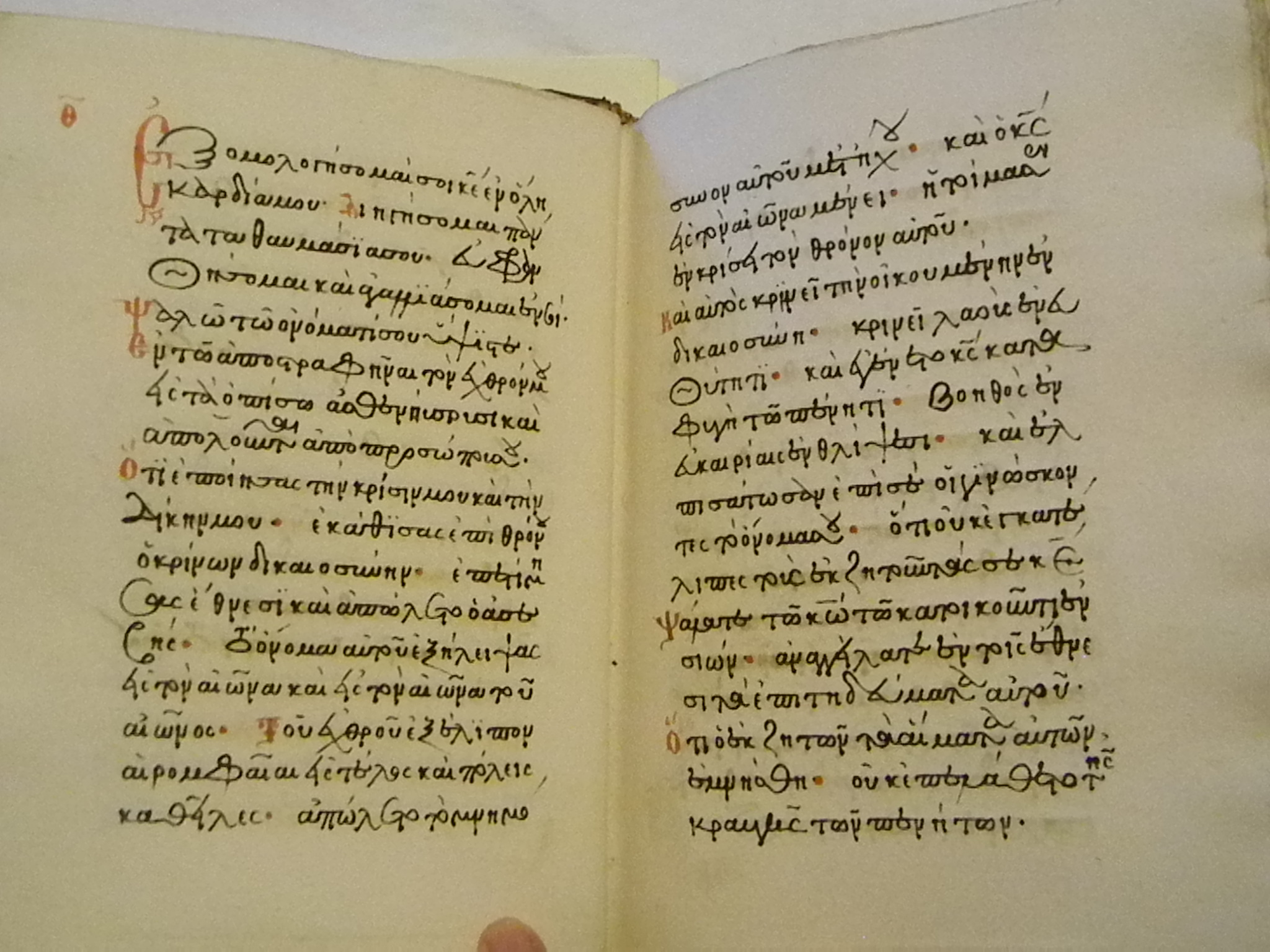
Ra 7029, ff. 11v–12r © Göttingen Academy of Sciences and Humanities in Lower Saxony 2023, photo: Maria Tomadaki
Ra 7024 is also of particular interest, as it is bound together with parchment fragments of an eleventh-century manuscript written in Perlschrift, which transmit resurrectional troparia from the Octoechos (Tone 2, Sunday).[iii]
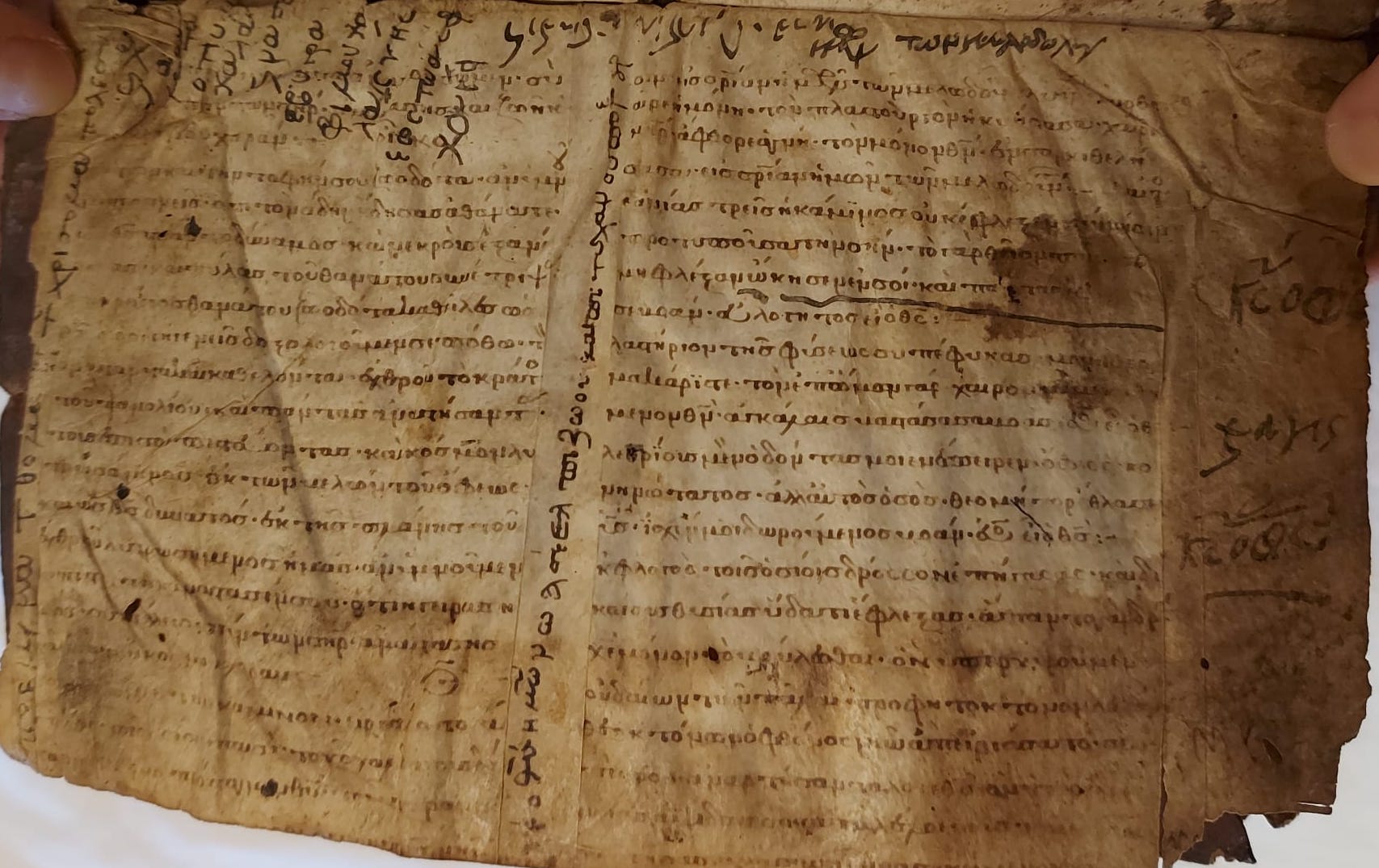
Ra 7024, f. Iv © Göttingen Academy of Sciences and Humanities in Lower Saxony 2023, photo: Maria Tomadaki
Several of the manuscripts from the Transfiguration Monastery have a characteristic old binding consisting of wooden boards, which are sometimes covered with leather.
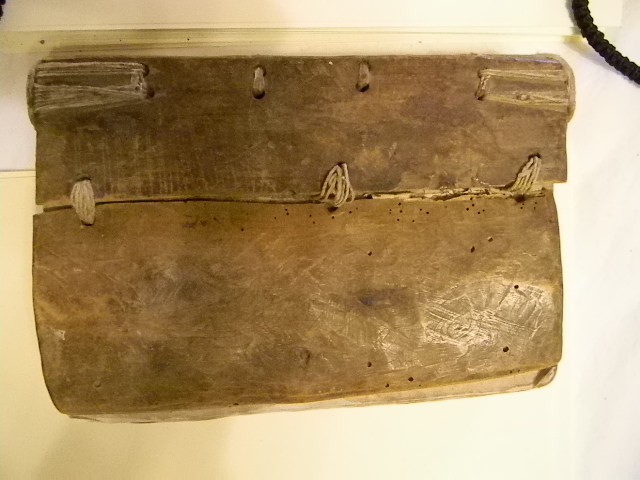
Ra 7028, Binding with Oak boards © Göttingen Academy of Sciences and Humanities in Lower Saxony 2023, photo: Maria Tomadaki
The Psalters of the Holy Trinity Monastery
Two Horologia (Books of Hours) currently kept at the Monastery of St. Stephen belong to the manuscript collection of the Holy Trinity Monastery. In 1909 Nikolaos Vees transferred these manuscripts from the Monastery of St. Nicholas Anapausas to the Holy Trinity Monastery for safety reasons.[iv] The first Psalter (Ra 7016) was written by three different scribes during the 15th–16th centuries and contains the Psalms 1–151, an Horologion, readings from the New Testament and several liturgical canons. It is also noteworthy that the manuscript transmits two glossaries (ff. 179r–182r) which interpret select words of the Psalms and the Odes. The glossaries are respectively entitled Λέξεις τῶν ἑκατῶν πεντήκοντα Ψαλμῶν (Words of the Hundred and Fifty Psalms) and Λέξεις τῶν ᾨδῶν (Words of the Odes). Their transmission was limited; another witness is the eleventh-century Vat. gr. 525 (ff. 1v–3v).[v]
The second Psalter (Ra 7017) is a composite sixteenth-century manuscript consisting of Psalms, ascetic prayers, a special Horologion compiled by the monk Thekaras, commentary on Thekaras᾽ hymns, and many akolouthiae (offices) for various saints (e.g., prophets, apostles, martyrs, hierarchs, female saints). Apart from penitential prayers and hymns, Thekaras᾽ Horologion contains several short texts on faith and on the Holy Trinity written by Pseudo-Dionysios, Justin the Philosopher, Gregory of Nyssa, Michael Synkellos, Theodoret of Cyrus, John Chrysostom, Gregory of Nazianzus, and Basil of Caesarea.[vi]
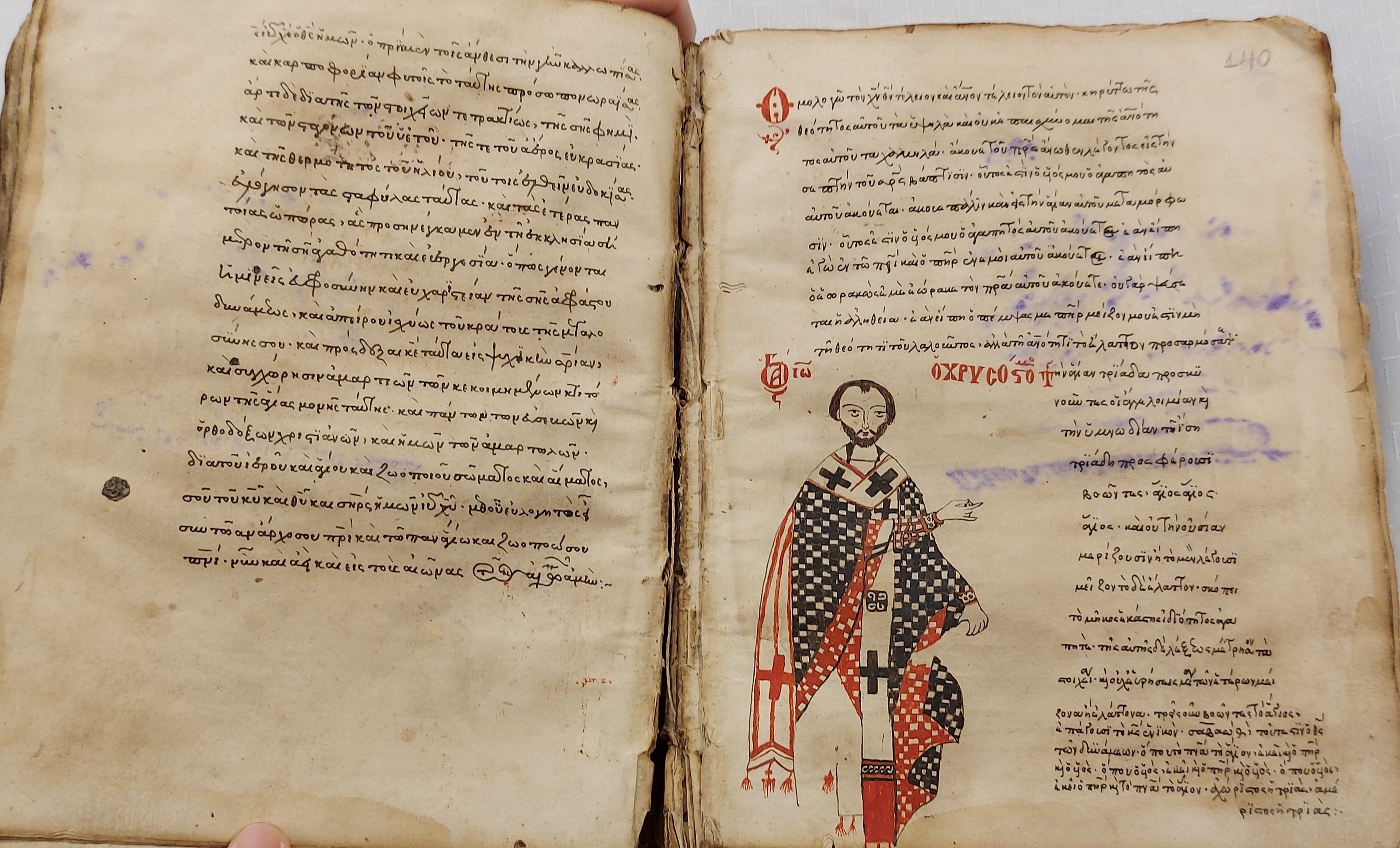
Miniature of John Chrysostom, Ra 7017, ff. 139v-140r © Göttingen Academy of Sciences and Humanities in Lower Saxony 2023, photo: Maria Tomadaki
The Psalters of the Varlaam Monastery
The Varlaam Monastery, which is also known for its rich collection of Byzantine and Post-Byzantine manuscripts, preserves five Psalter manuscripts and two Horologia from the 15th–16th centuries: Ra 7018, Ra 7019, Ra 7020, Ra 7021, Ra 7022, Varlaam 44 and Varlaam 45. Most of the Psalter manuscripts include Psalms and other liturgical texts, such as akolouthiae, canons and church calendars containing troparia dedicated to saints for the whole year (e.g., Ra 7019, Ra 7021, Ra 7022). The majority of the Psalters from the Varlaam Monastery preserve their old binding, which consists of wooden boards covered with leather. The two Horologia (Varlaam 44 and Varlaam 45) are beautifully decorated with ornamented headbands and enlarged initials and seem to have similar content. However, the first one is enriched with more liturgical hymns, such as the metrical calendars of Christopher of Mitylene, which are wrongly ascribed in the manuscript to Nicephorus of Mityline. What is also interesting is that at the front cover of a sixteenth-century Psalter (Ra 7018), a fragment of a Iatrosophion is attached as a paste-down providing information about the healing power of several herbs and flowers. Its edition and English translation will be presented in a forthcoming blogpost.
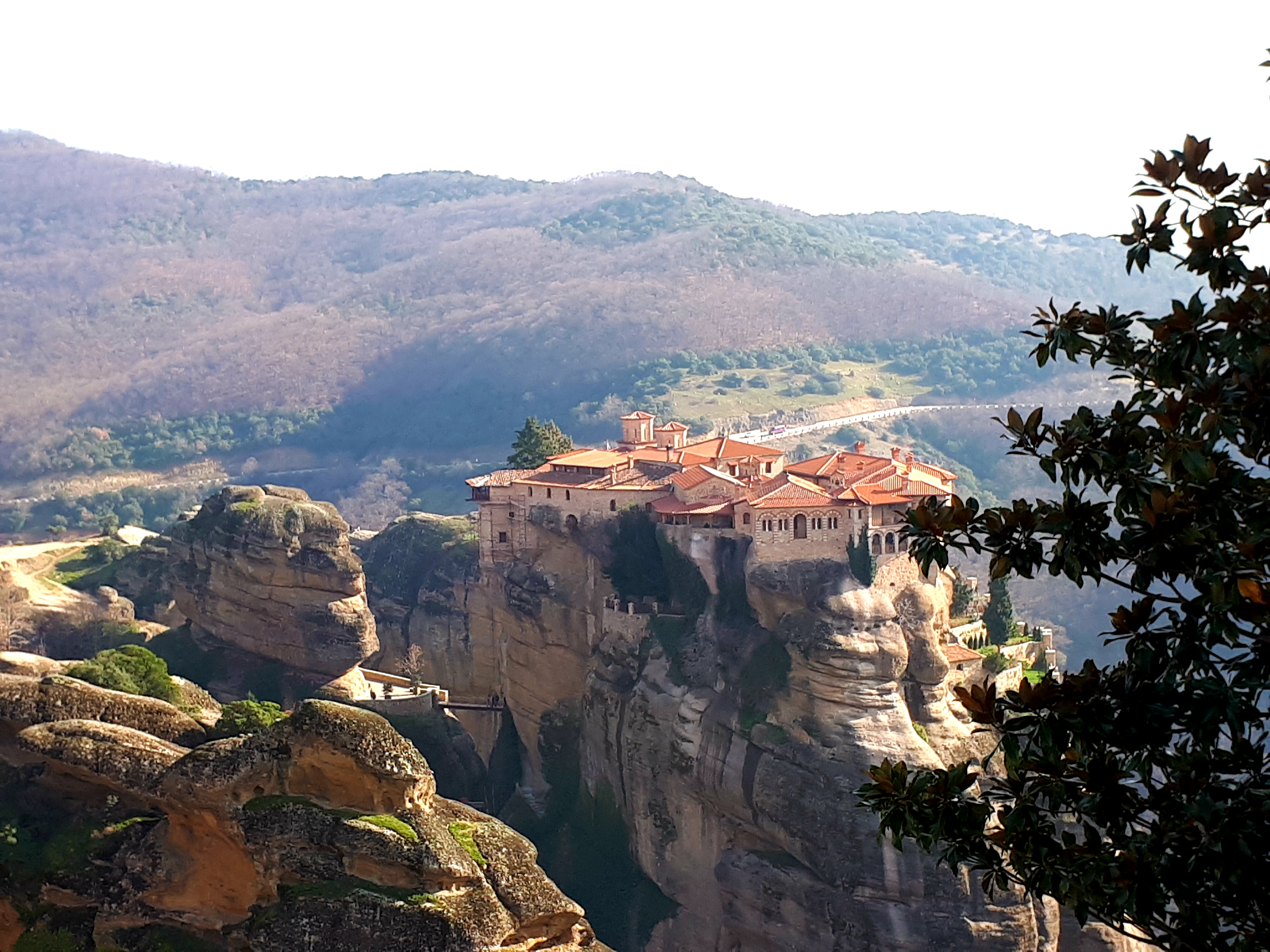
Varlaam Monastery © Göttingen Academy of Sciences and Humanities in Lower Saxony 2023, photo: Maria Tomadaki
The Psalter as a Shield against Demons
In two manuscripts (Ra 7023, Ra 7038) from the Transfiguration Monastery, the Psalms are preceded by an interesting poem in dodecasyllables, which highlights the Psalter’s role as a “shield” against demons and passions. We might argue that it indicates the importance and the particular role that the Psalter had in monastic communities. According to the poem, the chanting of the Psalms has a double and interrelated function: it pleases the Holy Trinity and the heavenly angels, and as it connects the earthly singers with the heavenly world, it protects the first from all kinds of evil spirits and temptations. I offer below an edition of the poem based on both manuscripts, as well as an English translation.[vii]
Στίχοι ἰαμβικοὶ
Πᾶσα μὲν γραφὴ δέος[viii] τοῖς δαιμονίοις,
τὸ δέ γε ψαλτήριον ἄφραστος τρόμος·
διώκων αὐτῶν τὴν συνάθροισιν πόρρω.
«κρεῖσσον» ἔφησεν ὁ χρυσοῦς Ἰωάννης
«σβεσθέντα τὸν ἥλιον μὴ φαίνειν ὅλως
ἤπερ[ix] τὸ ψαλτήριον λαβεῖν ἀργίαν[x]».
ψαλλόμενον γὰρ εὐλογεῖ καὶ δοξάζει
τὴν πανσθενουργὸν καὶ ὑπέρθεον φύσιν,
Θεὸν ὑπεράρχιον νοῦν, Λόγον, Πνεῦμα·
τοὺς δήμους τέρπει τῶν οὐρανίων νόων,
ἐκδειματοῖ[xi] πνεύματα τῆς πονηρίας,
φρουρεῖ ψυχάς, σώματα τῶν μετιόντων,
σοβεῖ πειρασμούς, τιθασεύει[xii] τὰ πάθη.
Οὗ κατατρυφῶν ὁ μέλλων ἀναγνῶναι,
μέμνησο τοῦ γράψαντος τοὺς στίχους τούτους,
εἰ καὶ τὰ ξύσματα[xiii] ἀνωφελῆ[xiv] ὑπάρχουν.
Iambic verses
Every scripture is a fear for the demons,
but the Psalter <is> an unutterable trembling,
driving away their gathering.
Τhe golden John said: “better the sun to be completely quenched
and not to shine, rather than the Psalter to be neglected”.
While it being chanted, it blesses and glorifies
the all–powerful and the most divine nature,
God the beginningless mind, the Word, the spirit.
It pleases the crowds of the heavenly angels,
it frightens the evil spirits,
it guards the souls <and> bodies of those who live together,
it scares away the temptations, calms down the passions.
Taking delight in <this Psalter>,
you who are about to read it,
think of the writer of these verses,
even though the letters[xv] are futile.
The previous poem resembles another one which I traced a few years ago while I was working for the Database of Byzantine Book Epigrams (Ghent University):
Ἔφη τὸ χρυσὸν τοῦ Ἰωάννου στόμα‧
«σβεσθῆναι τὸν ἥλιον συμφέρον μᾶλλον
ἤπερ[xvi] ἀργεῖσθαι ψάλλεσθαι, μελῳδεῖσθαι
ἐν τῇ τοῦ Θεοῦ ἁγίᾳ ἐκκλησίᾳ
τὸ ψαλτήριον ἕως τῆς συντελείας».[xvii]
The golden mouth of John said:
“It is better the sun to be quenched, rather
than neglect the chanting and singing of the Psalter
in God’s Holy Church
until the end of the world”.
Both poems evoke John Chrysostom’s words on the importance of chanting the Psalter, which are cited by Ioustinos Dekaduos in the preface of the Psalter edition by Aldus Manutius in 1494/1495.
Ταυτὶ γὰρ εὖ οἶδ᾽ ὅτι ταῖς κατὰ τόπον ἁγίαις τοῦ Θεοῦ ἐκκλησίαις πολλήν τε καὶ μεγάλην τὴν χρείαν παρέχεται· κατ᾽ ἐξαίρετον δ᾽ ἡ θεῖα τῶν Ψαλμῶν αὕτη βίβλος, περὶ ἧς φησιν ὁ θεῖος Χρυσόστομος μᾶλλον συμφέρειν τῷ κόσμῳ σβεσθῆναι τὸν ἥλιον ἤ περ τῇ 'Εκκλησίᾳ ταύτην ὁσημέραι μὴ ψάλλεσθαι.[xviii]
I know well that <these texts> will be of great use for the local churches of God. Especially the divine book of the Psalms, for which the divine Chrysostom says “it is better for the world the sun to be quenched rather than the <Psalter> not to be chanted every-day to the church”.
This phrase cannot be found in any other printed source; it seems therefore that it belongs to a nowadays lost work of John Chrysostom. Interestingly, a similar expression is quoted in the Thesaurus of Theognostos, a florilegium consisting of twenty chapters, which discuss Christian matters. The whole concluding paragraph of the florilegium is noteworthy for it stresses the apotropaic function of the Psalter and its role as a protective shield against demons:
Δεῖ δὲ γινώσκειν ὡς πᾶσαν μὲν ψαλμῳδίαν καὶ προσευχὴν δεδοίκασι καὶ φοβοῦνται οἱ πονηροὶ δαίμονες, ἐξαιρέτως δὲ τῶν ἄλλων πασῶν τὸ ψαλτήριον, περὶ οὗ καί τίς φησι τῶν ἁγίων ὅτι, «κρεῖσσόν ἐστι σβεσθῆναι τὸν ἥλιον καὶ μὴ φαίνειν ἐν κόσμῳ, ἢ ἀργῆσαι τὸ ψαλτήριον τοῦ μὴ ψάλλεσθαι.»[xix]
You need to know that that the cunning demons feared and fear every psalmody and prayer, but most of everything they fear the Psalter, for which one saint says that “it is better the sun to be quenched and not to appear in world rather than ceasing to chant the Psalter”.
Joseph A. Munitiz, who edited this florilegium, notes in his apparatus fontium that he was unable to trace the source of this quotation. Thanks to the epigrams and to the text of Ioustinos, it becomes clear that the “anonymous saint” mentioned in the florilegium should be identified with John Chrysostom.
Epilogue
The Psalter manuscripts of the Meteora monasteries were used either in the monastic cell or in church.[xx] Manuscripts that contain only the Psalter could have been used as personal prayer books, whereas the Horologia and Psalters combined with akolouthiae and other kinds of liturgical texts could have served the liturgical needs of the monasteries.[xxi] As regards some Psalters, which include alphabets, vernacular verses and notes by later possessors, they could have functioned as a kind of “primer” during the Ottoman period of Thessaly (e.g., Ra 7028).[xxii]
At the end of this note, I would like to express my sincere thanks to Αbbot Nephon of the Transfiguration Monastery, to Abbess Christonymphe of the St Stephen Monastery, and to Abbot Benedict of the Varlaam Monastery for their permission to study the Psalter manuscripts of their monasteries. I would also like to thank Father Varlaam, who kindly sent me digital copies of the Psalter manuscripts from the Varlaam Monastery. I am especially grateful to Father Chrysostom, librarian of the Transfiguration Monastery, and to Symeon, who facilitated my research there.
[i] I am grateful to my colleague Georgi Parpulov for his corrections. Any errors remain my own. The word “μετέωρος, meteoros” means “suspended in the air”.
[ii] Ra 7032 probably dates to the 15th century.
[iii] For their edition see Παρακλητικὴ ἤτοι Ὀκτώηχος ἡ μεγάλη, Rome 1885, pp. 462–467.
[iv] The Monastery of St. Nicholas Anapausas is located next to Kastraki, the closest village to the Meteora monasteries. It was probably founded in 14th century and is known for its beautiful frescoes painted in 1527 by the Cretan painter, Theophanes Strelitzas.
[v] See Parpulov, G., Toward a History of Byzantine Psalters, ca. 850–1350 AD, Plovdiv 2014, p. 171. Parpulov also mentions the editions of the glossaries: the glossary on the Psalms was edited by G. Pasini, Codices manuscripti Bibliothecae Regii Taurinensis Athenaei, vol. 1, Turin 1749, pp. 190–193, whereas the glossary of the Odes by J. Cramer, Anecdota Graeca e codd. manuscriptis bibliothecarum Oxoniensium, vol. 2, Oxford 1835, pp. 470–472.
[vi] The Thekaras anthology has a significant transmission in the Athonite manuscripts. It has been edited by the Iera Mone Pantokratoros, Στίχοι εἰς τοὺς θείους Ὕμνους. Διονυσίου καὶ Μητροφάνους, Περὶ τῶν Ὕμνων. Θηκαρᾶ Μοναχοῦ, Λόγοι περὶ πίστεως, Ἑρμηνεία τῶν Ὕμνων, Ὡρολόγιον τῶν θείων Ὕμνων, Ἀσκητικὴ Ἀκολουθία, Χαροποιὰ Πένθη. Θεοδούλου Μοναχοῦ, Διήγησις καὶ Ἀνθολόγιον περὶ τῶν Ὕμνων, Mount Athos 2008.
[vii] The poem can only be found in these two witnesses. Vees published a diplomatic transcription of it based on codex 7023, see A. Vees/ Vranousis, L./ Sophianos, D.: Τὰ χειρόγραφα τῶν Μετεώρων: κατάλογος περιγραφικὸς τῶν χειρογράφων κωδίκων τῶν ἀποκειμένων εἰς τὰς μονὰς τῶν Μετεώρων: τόμος Α´, τὰ χειρόγραφα τῆς μονῆς Μεταμορφώσεως (Μετέωρον), Athens 1998, p. 7. Part of the poem is preserved in the manuscript Hagiou Saba 77, see the Database of Byzantine Book Epigrams: https://www.dbbe.ugent.be/occurrences/25904
[ix] ὑπὲρ codd.
[x] ἀργείαν codd.
[xi] ἐκδηματεῖ codd.
[xii] τιθασέβει codd.
[xiii] ξίσματα codd.
[xiv] ἀνοφελὲς codd.
[xv] In Hesychios' lexicon the word “ξύσματα” is interpreted as “γράμματα” see K. Latte, Hesychii Alexandrini lexicon, vol. 2: E-X, Copenhagen 1966, p. 727.
[xvi] ὑπὲρ codd.
[xvii] On the text of the poem see: https://www.dbbe.ugent.be/types/31228
[xviii] The text of Ioustinos Dekaduos is reproduced in S. Pagliaroli, “L’ ultimo carattere greco di Aldo Manuzio”, in Fr. Donadi, St. Pagliaroli, A. Tessier, Manuciana Tergestina et Veronensia, Trieste 2015, pp. 98–99.
[xix] J.A. Munitiz, Theognosti Thesaurus (Corpus Christianorum Series Graeca 5), Turnhout 1979, p. 227.
[xx] Usually there is no colophon in the Psalters and therefore we cannot be sure about their origin and scribes. In other cases, there is a colophon, but it does not mention the place in which the manuscript was copied. Most of them possibly originate from Meteora, since they have stylistic similarities. However, Ra 7036 is written in intense black ink and seems to derive from Sinai, cf. the note of the monk Theophanes on f. 205r. Ra 7028 and Ra 7037 were copied by priests and Ra 7035 was copied by an hieromonk.
[xxi] On the function of the Psalter manuscripts as prayer books see G. Parpulov, “Psalters and Personal Piety in Byzantium”, in P. Magdalino – R. Nelson, The Old Testament in Byzantium, Washington D.C. 2010, pp. 77–105.
[xxii] See, for instance, the codices Ra 7028 and Ra 7032. Based on the notes of Ra 7028, Vees made the hypothesis that the Psalter was used as a “reading manual” during the Ottoman period, see A. Vees/ L. Vranousis/ D. Sophianos, Τὰ χειρόγραφα τῶν Μετεώρων: κατάλογος περιγραφικὸς τῶν χειρογράφων κωδίκων τῶν ἀποκειμένων εἰς τὰς μονὰς τῶν Μετεώρων: τόμος Α´, τὰ χειρόγραφα τῆς μονῆς Μεταμορφώσεως (Μετέωρον), Athens 1998 p. 116. It is well known that the Psalter was used as a kind of teaching manual during the period of Ottoman rule, see indicatively F. Iliou, Ιστορίες του ελληνικού βιβλίου, Heraklion, p. 363.
by Bonifatia Gesche, December 23, 2025
by Matteo Domenico Varca, November 30, 2025
by Anna Kharanauli, October 31, 2025
by Jonathan Groß, September 26, 2025
by Felix Albrecht, August 31, 2025
by Vadim Wittkowsky, July 31, 2025
by Bradley Marsh, June 30, 2025